Concerned with ‘divisive conclusions’ in Pelham school district’s racial equity audit
To the editor:
As a parent with my wife raising two school-age children in Pelham, I was very interested in the results of the equity audit recently commissioned by Pelham Union Free School District. The report lays out five recommendations to “promote racial justice and equity in Pelham.” Now having read the report and listened to the virtual school board presentation in October 2020, I am writing to share my concerns both with the equity audit’s research methodology and its conclusions.
The NYU Metropolitan Center for Research on Equity and the Transformation of Schools was engaged to produce the equity audit. Following New York State guidelines, the organization defines racial justice as: “The systematic fair treatment of people of all races that results in equitable opportunities and outcomes for everyone. All people are able to achieve their full potential in life, regardless of race, ethnicity or the community in which they live.”
“Systematic fair treatment… that results in equitable opportunities” is a just goal, as is the objective for “all people to be able to achieve their full potential in life.” But “equitable outcomes for everyone” runs directly counter to the proper aim that each student “achieves their full potential in life.” My two children are being raised by my wife and me: the same two parents with the same expectations in the same household. They each have significant potential, but will never achieve “equitable outcomes” because they are unique individuals with different skills, talents and interests—as is every child.
If two kids growing up under the same conditions are not going to end up with the same results, why would this audit seek to achieve “equitable outcomes” for an entire Pelham school district whose mission is committed to “Inspiring A Standard of Excellence For All Students.”
With that preface, I outline four areas of concern. My hope is that we as a Pelham community can come together to discuss the equity audit and the implications of its conclusions.
1. Generalization of Results
The first recommendation in the equity audit is that “Pelham leadership must methodically work to repair community harms,” and later describes Pelham as a “community where harm runs deep.” This and other generalized conclusions are largely based on the following series of lightly attended meetings:
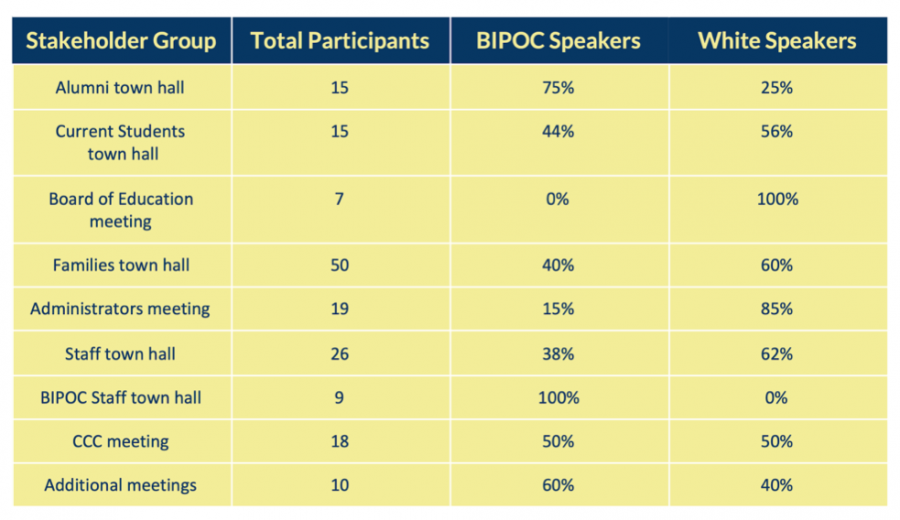
The report concedes that “Although town hall opportunities were provided to multiple stakeholder groups, the overall number of attendees was not high in proportion to the population of the district.” The report later explains low staff participation: “Out of 300+ staff members invited to the staff town hall, only 22 people were in attendance, which included Superintendent Dr. Cheryl Champ, Board of Education members and several administrators.” Not only are the numbers low; based on the overlapping descriptions of the “Stakeholder Groups,” it seems highly likely that the same people attended several meetings.
Moreover, the attendants of the meetings are broken up into BIPOC (Black, indigenous and people of color) and White speakers. Why? This artificial imposition of a singular extrinsic identity intentionally divides this non-representative sample of community participants into meaningless racial categories. Worse, it creates the false impression that a BIPOC or white speaker represents some monolithic view. That is an ugly stereotype and wrongheaded assumption. These types of amorphous racial groupings strip Pelham teachers and residents of the common humanity and individual dignity afforded by having one’s own opinions.
With such low, non-representative turnout and the insistent reduction of human beings to an immutable racial identity, this report is legitimately vulnerable to concerns that its divisive conclusions were pre-determined and/or not generalizable given the feedback driven by a very narrow sliver of participants.
2. Addressing Race-Based Patterns of Disparity
A second recommendation of the equity audit is to “Address race-based patterns of disparity and their intersections with other student identities.” While the report says there are “other identity-based patterns of disparity,” there is an overall focus on race—which will be my focus in this document. While never explicitly stated, consistent with critical race theory, there also seems to be an implicit message that whatever disparities do exist by race, they must be predominantly due to discrimination by race. This is especially sensitive given the national reckoning on race, and the recent controversies in Pelham around policing and race.
As evidence of the racial disparities in academic achievement, the equity audit states: “Multiracial and Black students’ proficiency rates decreased 3 to 8 percentage points in ELA, whereas Latinx students’ proficiency rate increased 1 percentage point.” And “From 2016-2018, several categories of students (Latinx, Black) underperformed the school average on both the new and old versions of the ELA assessment.” Seeing this data, I reviewed the official New York State Department of Education website detailing Pelham’s 2018-19 grade 3-8 state ELA assessment results.
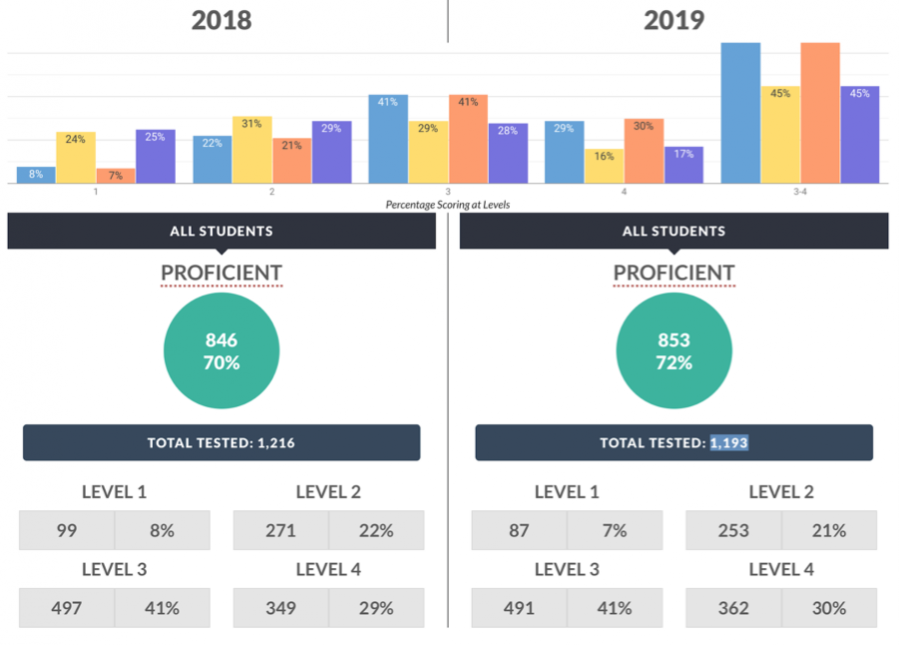
Overall (and pictured in the right hand column above), 72% (853 of 1,193) of Pelham 3rd-8th grade students passed the 2018-19 ELA state assessment. (Note that Level 3 plus Level 4 indicates passing). Broken down by race, 76% (602 of 787) of white students passed, while 33% (24 of 72) of Black students passed. The 72% to 33% differential clearly shows a racial disparity in that Black students passed at less than half the passing rate of white students. Looking more closely, even though 76% of white students passed the exam, 185 individual white students did not. 48 black students also did not pass. So there are almost four times the number of white students that failed the ELA state assessment as Black students, another racial disparity. Should we address these examples of race-based patterns of disparity by focusing our efforts on just one race of kids?
Of course not. That would be inequitable and unethical. The obsession with closing race-based disparities can often be a race to an average outcome versus the pursuit of excellence for every scholar.
Indeed, with Pelham’s mission committed to “Inspiring A Standard of Excellence For All Students,” perhaps another strategy to address race-based disparities would be to study success. What can we learn from Black, white and all students who passed the exams, and are flourishing more broadly? How many hours do they spend studying per night? Are they taking advantage of teacher tutoring hours? For students who entered the AP open-enrollment program and who are thriving, what led them there? Basically, how can we create more of what is working, by understanding the ingredients of success of kids of all races.
Another area that the equity audit calls out is the disproportionate rates of suspension, especially among Black boys. For example, the report states “In the middle school, every year looking from 2014 to 2019, male students, Black students, Latinx students and students with disabilities are disproportionately suspended at higher rates (*2016-2017 + 2017-2018 was proportional for Black students) See Appendix B, Figure 4.2 for detailed numbers.” Given the bolded instruction, I went to Figure 4.2, the last page of the Equity Audit.
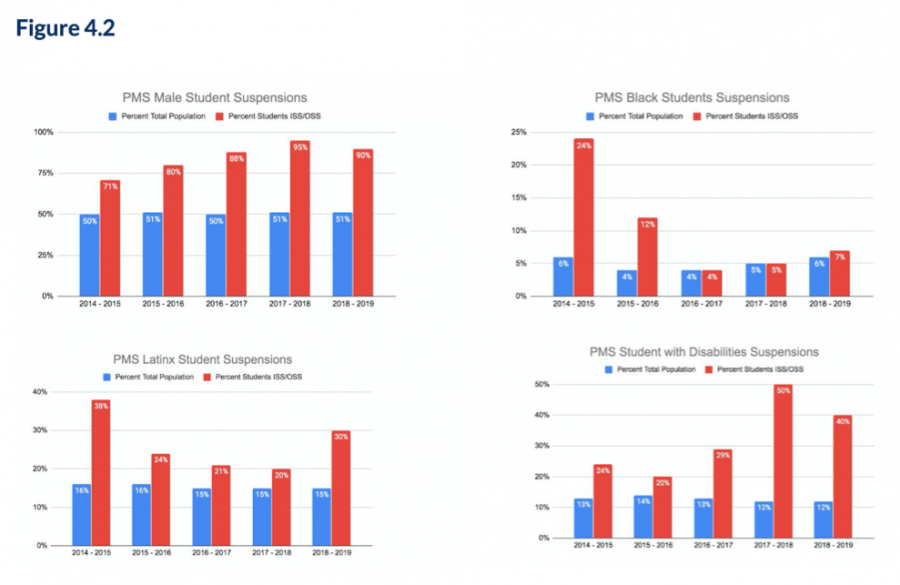
In analyzing Figure 4.2, the first observation is that the absolute number of suspensions is not revealed. Nor is it revealed the number of students that have been suspended, given that one student can have multiple suspensions. Without that data, how can the size of the issue be assessed?
Instead, only rates of suspension are presented. Moreover, notice that the scale in each of the four charts in Figure 4.2 is different. The scale of the chart on the left with the percent of male student suspensions is 0-100%. In contrast, the scale of the chart on the right with the percent of Black student suspensions is only 0-25%. Visually, this tactic creates an impression that Black student suspension rates are four times what they really are. This side-by-side presentation of the data distorts the incidences of black student suspension. More importantly, over the last three years, the ratio of Black Pelham Memorial High School students suspended as a percent of the overall number of kids suspended is 4%, 5% and 7%, all very low and virtually equal to the Black student representation in the district as a whole. Contrary to the NYU conclusions, there is no material racial disparity in Black student suspension rates at Pelham Middle School. Nevertheless, the narrative and the presentation in Figure 4.2 has the potential to falsely perpetuate a negative stereotype of Black male behavior when the data presented doesn’t support that conclusion. And of course, even if there is racial disparity, there is no data presented that suspensions of any student are driven by racial animus.
3. Diversify Hiring
A third recommendation in the equity audit is to “Diversify hiring and strengthen retention practices with the intention of growing and fostering affinity spaces available to BIPOC students, staff and families.” The report states that “In Pelham, where BIPOC students make up 34% of the population and BIPOC teachers make up only 9% of the staff population, there is great concern for lowered student expectations due to perceived potential.” I agree with the benefits of a staff diverse in race, gender, viewpoint, subject matter expertise and all the other characteristics that would compose a staff truly reflective of a multi-ethnic, multi-racial, pluralistic society.
But let’s not make the false assumption that the race of an individual gives them an inherent advantage or disadvantage as it relates to his or her ability to teach, or have low or high expectations of students. There are good and bad teachers of every race. When race is elevated to the point that it seems it is the only or predominant characteristic that matters in hiring, it can give the impression it was the only or predominant criteria for selection. In the name of achieving “racial equity,” this focus on exclusively hiring BIPOC teachers can easily fuel, as a Bridges of Pelham member posted on Facebook, a negative stereotypical perception that “BIPOC teachers are less qualified or that they’re hired only to serve BIPOC students.”
The equity audit calls out this concern: “Although the need for a more diverse and representative teaching staff is clear, some parents expressed disappointment at the idea that current Pelham teachers, specifically white teachers, could be replaced. One parent said, ‘I think that substituting out an excellent teacher who happens to be Caucasian, who happens to have grown up here, but who is an excellent teacher, I think, would also be doing the same kind of disservice that we’re talking about a lack of diversity doing. So I think that we can’t.’ Comments like this demonstrate the belief in the myth that increasing diversity will inherently lower the standards of an institution.” The less we focus on race as the sole or primary criteria for hiring and/or retention, the less this horrible stereotype of inferiority will be perpetuated.
4. Hutchinson School
In several sections of the equity audit, the Hutchinson School is called out as “the building with the highest percentage of BIPOC students and what some community members referred to as a more ‘transient population,’ in many cases coded language for renters as opposed to homeowners.” The report also includes a quote from a Pelham staff member: “People will literally refer to (Hutch) in meetings as if the school has the plague. It is very upsetting because there is nothing at all wrong with Hutch, so we need to do a better job showing that to the community. – BIPOC staff member.” After reviewing comments from the town hall conversations, welcoming policies documents and various leadership communication mailings, the equity audit included this finding: “There is a perception of racial divide amongst students, exacerbated by the negative narrative that follows students from Hutchinson Elementary.”
The report concludes saying that “Additionally, there was significant push back against the creation of a new building for Hutchinson Elementary, which as a white administrator explained, ‘is truly falling apart’ while at the same time another white administrator explained that ‘she listened to town people saying they don’t want their tax dollars going to ‘those kids.’”
With multiple mentions of the negative references of the Hutchinson School throughout the equity audit, it is surprising that there is no mention that on May 15, 2018, the Town of Pelham overwhelmingly voted for a pond proposition to build a new Hutchinson School.
The vote authorized a $46 million bond to build a new school to replace the Hutchinson School. As PUFSD’s Jan. 25 update communicated, “Throughout the fall, significant progress has been made on the new (Hutchinson) school, which remains on target to open in the fall of 2021. With the steel structure complete, contractors are now working to finish the facade and roof, at which point their attention will turn to the interior of the building. The district is working on purchasing furniture for the new classrooms. After the new school opens, demolition of the current building will commence to make way for the new field and playground.”
The vote on the bond attracted a huge turnout and resulted in Yes-1584; No-698, nearly a 70% to 30% split in favor of building a new Hutchinson School. In most election circles, that would be considered a landslide. For pictures of what Pelham is building for the Hutchinson School, go here. In contrast to the equity audit’s negative narrative surrounding the Hutchinson School, the overwhelming majority of Pelham residents have put that campus on a path to be the jewel of the district.
I believe Pelham residents of all races want to see our schools ensure each student reaches his or her full potential. In that spirit, we should all celebrate the middle school’s recent announcement being named as a New York State School of Character. Let’s build on this accomplishment and work together in ways that do not divide our community by race, do not demoralize valued faculty and school leadership and do not perpetuate negative stereotypes that we should be joined together in seeking to eliminate. Looking forward, I am hopeful as a town we will discuss the Pelham equity audit, but more importantly ensure how we uphold our commitment to the mission “Inspiring A Standard of Excellence For All Students.”
Ian Rowe
623 Francis St.




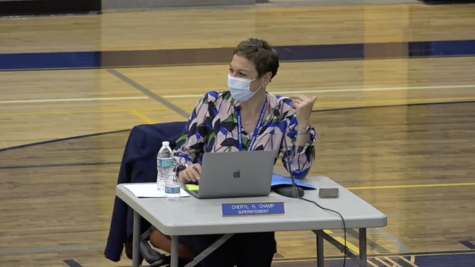
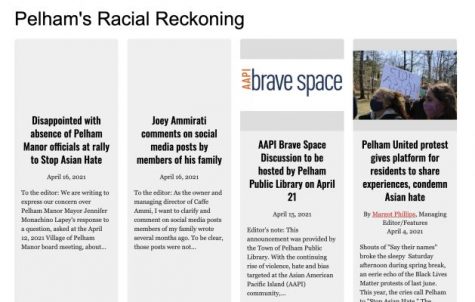
Nadine Leesang • Feb 10, 2021 at 9:53 pm
While I agree that there are certain flaws with the audit’s presentation of data, such as the misleading scales in the suspension graphs, I feel that your concerns expressed in this letter contribute to the divisive conclusions you mentioned.
Firstly, the term ‘equitable outcomes’ is not to be confused with equal outcomes. ‘Equitable outcomes’ refers to fair outcomes, which does not necessarily mean that each student will receive the same result. When organizations use this term, it refers to the additional resources provided for students to have fair opportunities for success.
Secondly, you mentioned that almost four times as many white students failed the ELA assessment than black students, but it is a reasonable proportion given that there were about ten times as many white students who took the test than black students. In fact, it is expected that many more white students would fail compared to black students. This is why we look at the proportion of students who failed by race. The findings do not suggest that schools should focus their efforts on just one race of kids. That is a conclusion that you came up with. If a student is struggling, a teacher should make their best effort to help that student. It doesn’t mean they would just stop teaching the class to focus on only one kid. Similarly, if a group of students with certain commonalities are struggling, we need to figure out the reason behind this and provide resources for them to better succeed. This does not mean students of other races would not be given attention.
There’s a plethora of reasons why some students do not perform as well as others, but I will tell you that experiencing racism does affect a student’s academic performance. I do not say this to suggest that with racial equity resources, every BIPOC student will perform well. I say this because I believe the disparity among races, in regards to certain academic areas, is not a coincidence. This equity audit isn’t perfect, in fact it’s far from it, but it is a step in the right direction of acknowledging how BIPOC students have been affected by growing up in a predominantly white district.
F. Spucci • Feb 3, 2021 at 10:17 pm
Well said Mr. Rowe. It’s about time that the Pelham Community stops and really looks at the school system. People have varying degrees of capability. We serve all best when we attempt to get the best possible results fore each individual student. Some will be brain surgeons and others not.
The real test is whether each student is given the tools and the respect to be the best he can be. If they choose well, great! If they choose to waste the opportunity, no amount of money or coercion will change the end result.